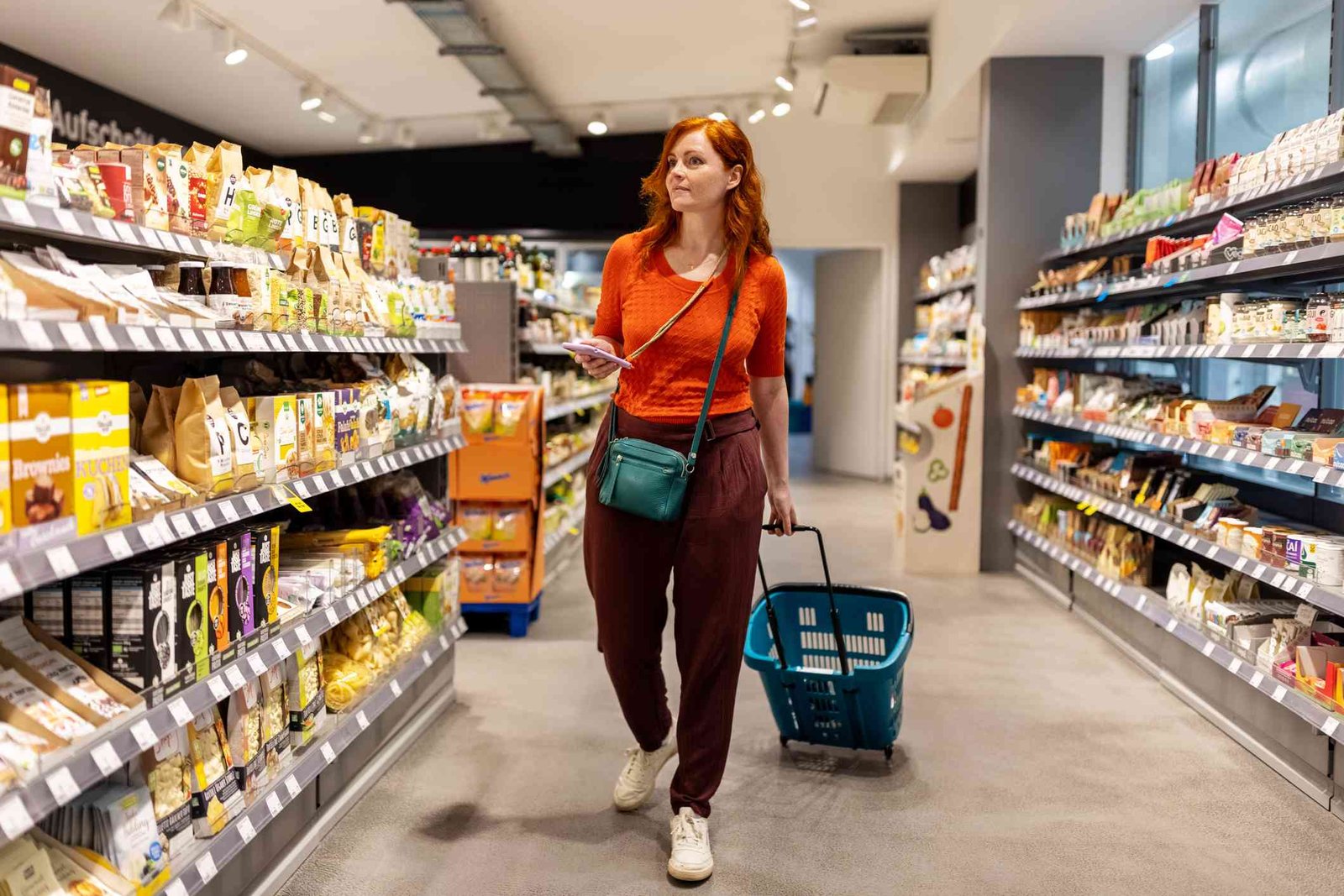As a registered dietitian who follows a high-protein diet, I know exactly which items can give me the most protein bang for my buck, while also supporting an overall healthy diet.
Here’s how I grocery shop to make sure I’m hitting my daily protein goals.
As a dietitian, I always make sure my meals and snacks are high in protein to help keep me satiated after eating, support healthy blood sugar levels, and promote muscle and bone health.
While I don’t track my macros, I do follow a high-protein diet. That means I eat more protein than the Recommended Dietary Allowance (RDA). Typically, people should aim for 0.8 grams of protein per kilogram of body weight. However, high-protein diets increase that to 1.2 grams of protein per kilogram (0.54 grams per pound) of body weight per day.
Increasing your protein intake can improve your health in many ways, from helping you gain muscle mass to reducing your risk of osteoporosis.
When I’m shopping, I always make an effort to fill my cart with protein-rich foods. Here are some examples of high-protein foods that can help you increase your protein intake.
Poultry and Eggs
I don’t eat red meat or pork, but I do eat chicken, turkey, and eggs, all of which are high in protein.
I like to buy high-quality, humanely-raised chicken, turkey, and egg products, such as pasture-raised chicken.
Seafood
Fish and shellfish are among the highest protein foods you can eat. To save money, you can purchase canned seafood products, like sardines, canned salmon, and canned tuna, which are less expensive than fresh seafood and have a shelf life of up to five years.
When possible, choose skipjack tuna, which contains about a third as much of the heavy metal mercury as albacore tuna.
- Canned salmon
- Canned tuna
- Sardines
- Frozen and fresh fish
- Shellfish, like clams and shrimp
Legumes
Legumes, like lentils and beans, are excellent sources of plant-based protein. I always keep canned and dried legumes on hand to add to salads, soups, and other dishes.
- Canned beans, such as black beans and chickpeas
- Dried lentils
- Dried beans, such as pinto beans
- Frozen edamame
Protein Powder and Collagen
Protein powder is an easy source of protein that can be added to smoothies and protein shakes. I also love to add collagen to my morning coffee or matcha.
- Collagen peptides
- Plant-based protein powders, such as unsweetened pea protein
- Whey protein isolate
Nuts, Seeds, and Nut Butters
Nuts and seeds are ready-to-eat sources of protein that can be added to dishes like oatmeal and yogurt or enjoyed as a quick snack.
My favorite high-protein nuts and seeds include pumpkin seeds, almonds, pistachios, and hemp seeds. Peanuts, which are technically a legume, are also high in protein.
I like to bake with almond flour, which contains around double the protein found in regular all-purpose flour.
- Peanuts and peanut butter
- Salted almonds
- Pumpkin seeds, hemp seeds, sunflower seeds, and chia seeds.
- Pistachios
- Almond flour
Dairy
Greek yogurt, cottage cheese, kefir, and snacking cheeses are some of my favorite high-protein dairy products. Greek yogurt contains nearly twice the amount of protein found in regular yogurt, so I always have a carton of high-quality Greek yogurt in my fridge.
- Unflavored kefir
- Full-fat Greek yogurt
- Cottage cheese
- Cheeses for snacking and cooking, such as parmesan
High-Protein Snacks
I like to stock up on easy, high-protein snacks that can be paired with other nutritious foods, like fruits and vegetables.
Be aware that many “high-protein” pre-made snacks, like bars, cookies, chips, shakes, and other snack foods, can be high in added sugar, salt, and other additives. I recommend reading nutrition labels so you know exactly what’s in your snacks or sticking to snacks made with limited ingredients.
- Turkey sticks
- Bite-sized snacking cheeses
- Individual packs of pistachios
- High-quality protein bars
While protein is important, it’s also essential to stock up on foods that provide complex carbs, healthy fats, vitamins, minerals, and protective plant compounds.
Fruits and Vegetables
- Fresh and frozen fruit, like berries, apples, bananas, and oranges
- Fresh and frozen vegetables, like onions, spinach, kale, carrots, zucchini, peppers, and asparagus
- Starchy vegetables, like potatoes, sweet potatoes, and butternut squash
Grains
I follow a gluten-free diet, so I like to purchase a variety of gluten-free grains.
- Quinoa
- Amaranth
- Brown rice
- Jasmine rice
- Millet
Healthy Fats
Healthy fats are important in any diet. My favorite source of fat is olive oil, which I use as a cooking and finishing oil.
- High-quality olive oil
- Avocado oil
- Avocados
- Olives
- Grass-fed butter
My husband and I cook most of our meals at home, so we always have a selection of spices and condiments to add flavor to our recipes.
- Spices, like turmeric and cumin
- Herbs, like basil, rosemary, and garlic
- Vinegars
- Mustard
- Salsa
- Hummus
- Mayonnaise
I like to create simple, high-protein meals for breakfast, lunch, and dinner. Here are a few of my go-to recipes.
Breakfast
- Egg frittata made with eggs, fresh vegetables, and cheddar cheese
- High-protein smoothie made with frozen berries, protein powder, and peanut butter
Lunch
- Chicken salad served with almond flour crackers, veggies, and hummus dip
- Mediterranean quinoa salad made with chickpeas, feta, and mixed vegetables
Dinner
- Whole roasted chicken served with root vegetables and garlic-sautéed broccoli
- Almond crusted fish served with sweet potatoes and a salad
To make sure my kitchen is always stocked with nutritious options, I go grocery shopping once a week. Keep in mind that, depending on the size of your household and how often you cook, you may need to shop more or less frequently than I do.
I don’t follow a list, but if you often get sidetracked at the store or are likely to make impulse purchases, I suggest making and sticking to a shopping list.
If I want to try out new recipes, I write down new ingredients I might need in addition to my weekly staples. Since I have a well-stocked pantry full of shelf-stable items like canned beans, protein powders, and grains, my shopping cart is mostly full of fresh foods, like fruits, vegetables, and dairy products.
Though it’s important to purchase protein-rich foods, it’s best to buy a variety of options, including plant-based proteins. Plant-based proteins, like beans and lentils, are shelf-stable, so it’s always a good idea to buy canned or dried legumes in bulk so you always have a nutritious protein source to add to meals and snacks. Plant-based proteins are also high in fiber, which is important for gut and heart health.
Also, when purchasing perishable items, like chicken or yogurt, be sure to only buy what you’ll use. While some protein sources, like chicken and fish, can be frozen, others, like yogurt or milk, can spoil if left in the fridge too long.
Your protein needs depend on factors like your body size and your activity levels. If you’re unsure how much protein you should be consuming, it’s best to speak with a healthcare provider, like a registered dietitian. They can calculate your protein needs and help you come up with a meal plan based on your goals. Then, you can create a shopping list based on your meal plan.
Protein is essential for health, which is why I fill my grocery cart with protein-rich foods.
Shopping for high-protein foods that you can easily incorporate into meals and snacks can improve your overall nutrition and help you achieve your health goals.


